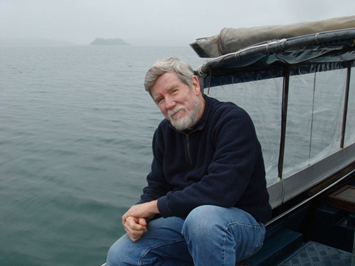
搜索网站、位置和人员

新闻与活动 活动信息
西湖名师论坛第五十五期 | Willard S. Moore: The Lost City Hydrothermal Field: A Possible Model System for Life’s Beginnings Studied with Radium Isotopes
时间
2019年10月11日(周五)
下午13:30-15:00
地点
西湖大学云栖校区5号楼一楼学术报告厅
主持
西湖大学工学院讲席教授 李凌
受众
全体师生
分类
学术与研究
西湖名师论坛第五十五期 | Willard S. Moore: The Lost City Hydrothermal Field: A Possible Model System for Life’s Beginnings Studied with Radium Isotopes
时间:2019年10月11日(周五)下午13:30-15:00
Time:1:30-3:00 PM, Friday, Oct 11, 2019
地点:西湖大学云栖校区5号楼一楼学术报告厅
Venue:Lecture Hall, 1F, Building 5, Yunqi Campus
主持人:西湖大学工学院讲席教授 李凌
Host:Ling Li, Chair Professor of School of Engineering, Westlake University

主讲人/Speaker:
Dr. Willard S. Moore, Distinguished Professor Emeritus, School of Earth, Ocean, and Environment, University of South Carolina, USA
Willard S. Moore received his doctorate degree in earth and space sciences from State University of NY. He has served on the National Advisory Council/National Research Council, the international commission on Marine science (SCOR), and the Groundwater Discharge Working Group. Professor emeritus Willard Moore was elected as a Fellow of American Geophysical Union in 2006 and Fellow of the American Association for the Advancement of Science in 2014.
The primary research of his laboratory is based on the use of natural radioisotopes as tracers of geological and oceanographic processes. By measuring precisely radioisotopes that result from the decay of uranium and thorium in the environment, his group investigates such diverse topics as interactions of river water and sediments with sea water; flow of ground water through salt marshes; the mixing rate of the ocean; hydrothermal processes at ocean spreading centers; the internal structure of minerals; the ages, rates, and processes of formation of manganese nodules; the rate of growth of corals; and sea level changes.
讲座摘要/Abstract:
The Lost City hydrothermal field was discovered in 2000 about 15 km away from the axis of the Mid-Atlantic Ridge. It was unlike typical basalt-hosted hydrothermal systems in terms of geology and fluid composition. Towering carbonate chimneys (up to 60 m) reached within 750 m of the sea surface. Fluids emanating from the system were warm (40-90°C), alkaline (pH 8-10), depleted in Mg and rich in methane and hydrogen. These fluids derive from reactions between seawater and uplifted mantle peridotite. The presence of hydrogen (over 10 mM) suggested that abiotic processes produce the methane, a key step to producing more complex organic compounds. Some have suggested that sites like Lost City may serve as a model for sites were life began.
Outstanding questions concerning the Lost City site include (1) How old is the system? (2) What is the flux of seawater through the system? (3) What is the residence time of fluids in the system? These questions bear directly on the chemical reactions producing the unique fluid composition.
In 2018 we discovered exceptionally high activities (10-100 dpm/L) of excess223Ra (half-life = 11 days) in fluids from the Lost City hydrothermal field. These activities surpass any published measurements of223Ra in seawater or other hydrothermal fluids by factors of 50 to 500. In sharp contrast to fluids from basalt-hosted settings, no other radium isotopes have unusually high activities in these fluids. In fact,228Ra and224Ra are below detection and226Ra is ~1 dpm/L. In basalt-hosted systems, high (10-70 dpm/L)226Ra and228Ra activities are thought to arise from leaching of the basalt by hydrothermal fluids. Basalt-hosted systems have223Ra/226Ra activity ratios (ARs) <0.05; at Lost City this AR is 10-100, indicating the radium signal is not due to rock alteration.
We postulate that serpentines accumulate uranium from seawater during their formation; thus, the U concentration is an index of the volume of fluid used to produce the serpentine. With time226Ra and223Ra are produced and may be removed by circulating fluids. Because of its long half-life (1600 years),226Ra requires hundreds of years to regenerate after it is leached, while223Ra regenerates completely within 2 months. Thus, the223Ra activity constrains the age of the system and the223Ra/226Ra AR constrains the residence time of the fluids.
讲座联系人/Contact:
科技合作部 沈老师
shenxiaolian@westlake.edu.cn

















